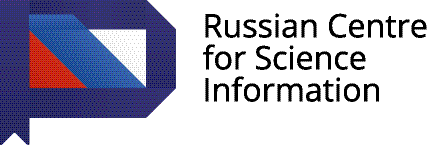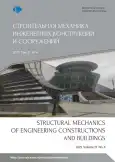Numerical Simulation of the Restoring Effect from Post-Stress in the Slab of a Cast-in-Situ Reinforced Concrete Frame
- 作者: Gaidzhurov P.P.1, Savelyeva N.A.1, Bris Robin Z.2
-
隶属关系:
- Don State Technical University
- Platov South Russian State Polytechnic University
- 期: 卷 21, 编号 4 (2025)
- 页面: 294-306
- 栏目: Analytical and numerical methods of analysis of structures
- URL: https://bakhtiniada.ru/1815-5235/article/view/349858
- DOI: https://doi.org/10.22363/1815-5235-2025-21-4-294-306
- EDN: https://elibrary.ru/BOTCDZ
- ID: 349858
如何引用文章
全文:
详细
A technique has been developed for finite element modeling of reinforcement of a cast-in-situ floor slab of a repeating fragment of a cast-in-situ frame with pre-stressed cables without adhesion to concrete. The analysis of the stress-strain state of the fragment, taking into account post-stress, is performed in linearly elastic setting. Three-dimensional plate and beam finite elements of the ANSYS Mechanical computational software were used to assemble the studied frame structure. The proposed concept of modeling the restoring force from a prestressed cable to concrete is based on the following sequence of steps: first, using truss and combined finite elements of the ANSYS Mechanical software, the plane problem of determining vertical and horizontal reactions caused by cable tension is solved, then spline interpolation of the obtained values of vertical reactions for setting the appropriate nodal forces on the slab elements is performed. The numerical simulation of the resulting restoring effect from the post-stress created in the floor slab is implemented using two-dimensional interpolation of the displacement distributions from the pre-stress according to two specified schemes onto an auxiliary regular finite element grid with subsequent superposition. The calculation results were compared using the proposed approach and methodology of the A.A. Gvozdev Scientific Research, Design and Technological Institute of Concrete (NIIZHB).
作者简介
Peter Gaidzhurov
Don State Technical University
编辑信件的主要联系方式.
Email: gpp-161@yandex.ru
ORCID iD: 0000-0003-3913-9694
SPIN 代码: 6812-9718
Advisor of the Russian Academy of Architecture and Construction Sciences, Doctor of Technical Sciences, Professor of the Department of Structural Mechanics and Theory of Structures
1 Gagarin Sq., Rostov-on-Don, 344003, Russian FederationNina Savelyeva
Don State Technical University
Email: ninasav86@mail.ru
ORCID iD: 0000-0002-8702-5168
SPIN 代码: 8437-8080
Candidate of Technical Sciences, Senior Lecturer of the Department of Structural Mechanics and Theory of Structures
1 Gagarin Sq., Rostov-on-Don, 344003, Russian FederationZu Bi Ti Bris Robin
Platov South Russian State Polytechnic University
Email: robin.zu.92@inbox.ru
ORCID iD: 0009-0005-1886-8777
post-graduate student of the Department of Industrial and Civil Engineering, Geotechnology and Foundation Construction
132 Prosvecheniya St, Novocherkassk, Rostov region, 346428, Russian Federation参考
- Lin T.Y., Burns N.H. Design of prestressed concrete structures. Wiley Publ.; 1981. ISBN-10 9812531173
- Mikhailov K.V., Volkov Yu.S. Prestressed reinforced concrete: the state and prospects of development. Concrete and reinforced concrete. 2023;(5/6):7–10. (In Russ.) EDN: PXJNZR
- Wight J.K. Reinforced concrete: Mechanics and design. Pearson Publ.; 2013. ISBN 10 1-292-10600-X
- Mikhailov V.V. Prestressed reinforced concrete structures: (Theory, calculation and selection of sections). Moscow: Stroyizdat Publ.; 1978. (In Russ.) Available from: https://dwg.ru/dnl/8087 (accessed: 20.04.2025).
- Gibshman E.E., Gibshman M.E. Theory and calculation of prestressed reinforced concrete bridges. Moscow: Avtotransizdat Publ.; 1963. (In Russ.) Available from: https://dwg.ru/dnl/10396 (accessed: 20.04.2025).
- Portaev D.V. Calculation and construction of prestressed structures of civil buildings. Moscow: DIA Publ.; 2011. (In Russ.) ISBN 978-5-93093-824-1 EDN: QNPMDF
- Wolanski A.J. Flexural behavior of reinforced and prestressed concrete beams using finite element analysis. Marquette University, 2004. Available from: https://epublications.marquette.edu/theses/4322 (accessed: 20.04.2025).
- Abdelatif A.O., Owen J.S., Hussein M.F.M. Hussein Modelling the prestress transfer in pre-tensioned concrete elements. Finite Elements in Analysis and Design. 2015;94:47–63. https://doi.org/10.1016/j.finel.2014.09.007
- Ibrahim A.M., Mubarak H.M. Finite element modeling of continuous reinforced concrete beam with external prestressing. 2010 Concrete Bridge Conference: Achieving Safe, Smart & Sustainable Bridges. 2010:1–12. Available from: https://www.researchgate.net/publication/268982383 (accessed: 20.04.2025).
- Hartl H., Sparowitz L, Elgamal A. The 3D computational Modeling of Reinforced and Prestressed Concrete Structures. Proceedings of the 3rd International PhD Symposium in Civil Engineering. Vienna, 2000;2:69–79. Available from: https://www.researchgate.net/publication/228540729 (accessed: 20.04.2025).
- Ayoub F.C. Filippou F.C. Finite-element model for pretensioned prestressed concrete girders. Journal of Structural Engineering. 2010;136:401–409. https://doi.org/10.1061/(ASCE)ST.1943-541X.0000132 EDN: OEKDXF
- Colajanni P., Recupero A., Spinella N. Design procedure for prestressed concrete beams. Computers and Concrete. 2014;13(2):235–253. https://doi.org/10.12989/cac.2014.13.2.235
- Ahn J.H., Jung C.Y., Kim S.H. Evaluation on structural behaviors of prestressed composite beams using external prestressing member. Structural Engineering and Mechanics. 2010;34(2):247–275. https://doi.org/10.12989/sem.2010.34.2.247 EDN: OEJQPL
- Prokopovich A.A. Bending resistance of reinforced concrete structures with different conditions of adhesion of longitudinal reinforcement to concrete. Samara: NVF Sensors. Modules, Systems Publ.; 2000. (In Russ.) Available from: https://djvu.online/file/XP8BprJZYRgEp (accessed: 20.04.2025).
- Di Luzio G., Cedolin L., Beltrami C. Tridimensional long-term finite element analysis of reinforced concrete structures with rate-type creep approach. Applied Sciences. 2020;10(14):4772. https://doi.org/10.3390/app10144772
- Manie J. DIANA — Finite Element Analysis User’s Manual release 9.4.4. 2011. Available from: https://dianafea.com/ manuals/d944/ConcMas/ConcMas.html (accessed: 20.04.2025).
- Dzyuba I.S., Vatin N.I., Kuznetsov V.D. Monolithic large-span ribbed overlap with poststressing. Magazine of Civil Engineering. 2008;(1):5–12. EDN: NBMYCH
- Gaidzhurov P.P., Al-Jabobi S.F., Al-Yaj M.A.H. Finite element modeling of force transmission the tension of the steel tendon on the concrete. Bulletin of Higher Educational Institutions. North Caucasus Region. Technical Sciences. 2017;(2):73–78. (In Russ.) https://doi.org/10.17213/0321-2653-2017-2-73-78 EDN: YTPOFH
- Gaidzhurov P.P., Iskhakova E.R., Savelyeva N.A. Influence of concrete creep on the bending of a prestressed bridge beam. Reinforced concrete structures. 2023;3(3):3–10. (In Russ.) https://doi.org/10.22227/2949-1622.2023.3.3-10 EDN: NJWSGW
- Ketkov Yu.L., Ketkov A.Yu., Schultz M.M. MATLAB 6.x: programming numerical methods. St. Petersburg: BHV-Petersburg Publ.; 2004. (In Russ.) ISBN 5-94157-373-1 EDN: QMNBMP
补充文件









